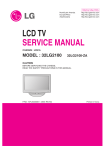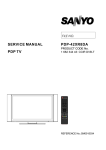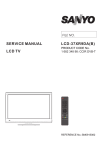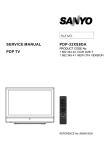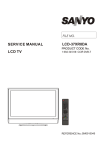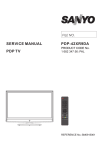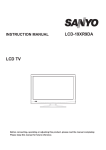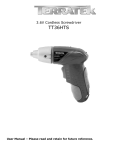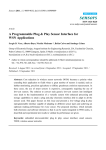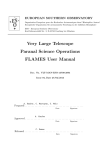Download lcd-19xr9da_sm11.35 MB
Transcript
FILE NO. SERVICE MANUAL LCD-19XR9DA LCD TV PRODUCT CODE No. 1 682 346 34: PAL-BG(TV) DTV REFERENCE No.:SM0915063 CONTENTS Safety precautions………………………………………………………………………..… 1 Alignment instructions …………………………….…….………………………………… 3 Method of software upgrading…………………………………………………………….. 8 Working principle analysis of the unit……………………………….………….………….12 Block diagram…………………………………..………………………………….…………13 IC block diagram………………………………………………………………………..……14 Wiring diagram ……………………………………………………………………………. 25 Troubleshooting guide ………………………………………………………………..…… 26 Schematic diagram………………………………………………………………………… 31 APPENDIX-A: Assembly list APPENDIX-B: Exploded View Attention: This service manual is only for service personnel to take reference with. Before servicing please read the following points carefully. Safety precautions 1. Instructions Be sure to switch off the power supply before replacing or welding any components or inserting/plugging in connection wire Anti static measures to be taken (throughout the entire production process!): a) Do not touch here and there by hand at will; b) Be sure to use anti static electric iron; c) It’s a must for the welder to wear anti static gloves. Please refer to the detailed list before replacing components that have special safety requirements. Do not change the specs and type at will. 2. Points for attention in servicing of LCD 2.1 Screens are different from one model to another and therefore not interchangeable. Be sure to use the screen of the original model for replacement. 2.2 The operation voltage of LCD screen is 700-825V. Be sure to take proper measures in protecting yourself and the machine when testing the system in the course of normal operation or right after the power is switched off. Please do not touch the circuit or the metal part of the module that is in operation mode. Relevant operation is possible only one minute after the power is switched off. 2.3 Do not use any adapter that is not identical with the TV set. Otherwise it will cause fire or damage to the set. 2.4 Never operate the set or do any installation work in bad environment such as wet bathroom, laundry, kitchen, or nearby fire source, heating equipment and devices or exposure to sunlight etc. Otherwise bad effect will result. 2.5 If any foreign substance such as water, liquid, metal slices or other matters happens to fall into the module, be sure to cut the power off immediately and do not move anything on the module lest it should cause fire or electric shock due to contact with the high voltage or short circuit. 2.6 Should there be smoke, abnormal smell or sound from the module, please shut the power off at once. Likewise, if the screen is not working after the power is on or in the course of operation, the power must be cut off immediately and no more operation is allowed under the same condition. 2.7 Do not pull out or plug in the connection wire when the module is in operation or just after the power is off because in this case relatively high voltage still remains in the capacitor of the driving circuit. Please wait at least one minute before the pulling out or plugging in the connection wire. 2.8 When operating or installing LCD please don’t subject the LCD components to bending, twisting or extrusion, collision lest mishap should result. 2.9 As most of the circuitry in LCD TV set is composed of CMOS integrated circuits, it’s necessary to pay attention to anti statics. Before servicing LCD TV make sure to take anti static measure and ensure full grounding for all the parts that have to be grounded. 2.10 There are lots of connection wires between parts behind the LCD screen. When servicing or moving the set please take care not to touch or scratch them. Once they are damaged the screen 1 would be unable to work and no way to get it repaired. If the connection wires, connections or components fixed by the thermotropic glue need to disengage when service, please soak the thermotropic glue into the alcohol and then pull them out in case of dagmage. 2.11 Special care must be taken in transporting or handling it. Exquisite shock vibration may lead to breakage of screen glass or damage to driving circuit. Therefore it must be packed in a strong case before the transportation or handling. 2.12 For the storage make sure to put it in a place where the environment can be controlled so as to prevent the temperature and humidity from exceeding the limits as specified in the manual. For prolonged storage, it is necessary to house it in an anti-moisture bag and put them altogether in one place. The ambient conditions are tabulated as follows: Temperature Humidity Scope for operation 5 ~ +40 oC Scope for storage -20 ~ +60 oC Scope for operation 20% ~ 85% Scope for storage 10% ~ 90% 2.13 Display of a fixed picture for a long time may result in appearance of picture residue on the screen, as commonly called “ghost shadow”. The extent of the residual picture varies with the maker of LCD screen. This phenomenon doesn’t represent failure. This “ghost shadow” may remain in the picture for a period of time (several minutes). But when operating it please avoid displaying still picture in high brightness for a long time. 3. Points for attention during installation 3.1 The front panel of LCD screen is of glass. When installing it please make sure to put it in place. 3.2 For service or installation it’s necessary to use specified screw lest it should damage the screen. 3.3 Be sure to take anti dust measures. Any foreign substance that happens to fall down between the screen and the glass will affect the receiving and viewing effect 3.4 When dismantling or mounting the protective partition plate that is used for anti vibration and insulation please take care to keep it in intactness so as to avoid hidden trouble. 3.5 Be sure to protect the cabinet from damage or scratch during service, dismantling or mounting. 2 Alignment instructions 1. Test equipment VG-848 (YPbPr,VGA signal generator) VG-849 (HDMI signal generator) CA210 (white balancer) 2. Power test Connect power board, digital processing board, IR board and backlight board according the wiring diagram, connect the power and press to turn on the TV. Test the pin voltage of X401, the data is shown in table1: Table1 voltage data of X401 X401 Pin1 2 3 4,5 6,7 8 9 10 11 12 13 Voltage ≤3.3V 0 ≤3.3V 12V±5% 0 32V±5% 5V±5% 0 5V±5% 0 ≤3.3V 3. Alignment flow-chart The alignment flow-chart is shown as fig-1 Check if EDIT, HDCP KEY, FLASH are written Combined test for general assembly White balance adjustment Connect to the center signal source and check each function of TV (station leaking, analog control, etc.) check the output of earphone and speaker. Input AV signal and check the function Input Component signal and check the function of YPbPr Input D-SUB signal and check if the display is normal, check the function (analog control), horizontal/vertical center, etc. Input HDMI signal and check if the display is normal, check the function (analog control), horizontal/vertical center, etc. Check the other functions (LCN, OTA) 3 Preset ex-factory Fig-1 adjustment flow-chart 4. Adjustment instruction 4.1 Unit adjustments 4.1.1Connect all the boards according to wiring diagram, then power on and observe the display. 4.1.2 Method for entering factory menu: a) Press “SOURCE”, “2”, “5”, ”8” and “0” in turn to enter factory menu; b) Press “ ” and “ ” to move the cursor to the adjustment page of the level one factory menu, then press ”OK” to enter; c) Press “ ” and “ ” to move the cursor up and down; d) Press “ ” and “ ” to adjust the item when the cursor move to a certain adjust item; e) Press “MENU” to exit to the previous factory menu; f) Press “EXIT” to exit the factory menu at any situation; g) Press “OK” to enter the sub factory menu; h) ADC ADJUST, ADC correction of VGA, Component channel; i) W/B ADJUST, white balance adjustment; j) POWER MODE, set the turn-on modes. Standby---standby when power on; Mem---memory; ForceOn---power on; ForceOn can be used for aging; set the “power mode” to “Standby” when preset ex-factory unless the client appointed it; k) ISP MODE, ON---soft upgrading through VGA port with ISP instrument, OFF---DDC function of VGA; the setting will not be memory and will be “OFF” when power on again; l) RESTALL, initialization of the factory and user data; after this item is confirm, the unit will restart and display the guiding image. m) FACTORYDATAREST, factory data initialization (including white balance adjustment, ADC correction and other adjusted data); n) FACEORY Channel PRESET, preset the factory channel; please connect to the center signal source when operating; the present digital frequency is CH28(529.5MHz), CH33(564.5MHz) for Australia, if the signal changes, perform “DTV manual search” in “Channel” menu and the operation needs 15s or so. o) CUSTOM Channel PRESET, preset the custom ATV channel, they are CH2(66.5MHz), CH7(184.5MHz), CH9(198.5MHz), CH10(212.5MHz), CH28(529.5MHz); p) MST DEBUG, the default is OFF. OFF---RS-232 should match the design criterion; ON--- it should be convenient for using exploitation tool to adjust. The setting will not be memory and will be “OFF” when power on again; q) BACKLIGHT: adjust the backlight brightness, adjust the data and test the voltage of X804 pin2 (PWM), let the voltage to be the corresponding PWM voltage which the brightness is maximum. It will be preset and doesn’t need adjust. r) SSC ADJUST, adjust the frequency spectrum expand, it will be preset and doesn’t need adjust. s) AUDIO CURVE, adjust the sound curve, it will be preset and doesn’t need adjust. t) RF AGC delay Adj, adjust ATV RF AGC-take; u) There is data in EEPROM after software upgrade, please perform REST ALL before the first adjustment. 4 4.1.3 ADC correction in D-SUB channel a) Switch to D-SUB channel b) Press” SOURCE”, then press “2, 5, 8, 0” in turn to enter the level one factory menu. c) Move the cursor to “ADC ADJUST” and press OK to enter the sub-menu. d) Input D-SUB signal (VG-848 Timing:856(1024x768/60Hz), Pattern:920 8step Gray). Move the cursor to “MODE”, press and to select “RGB”, move the cursor to “AUTO ADC” and press OK to adjust automatically till display “success”. 4.1.4 ADC correction of Component channel a) Switch to Component channel. b) Press” SOURCE”, then press “2, 5, 8, 0” in turn to enter the level one factory menu. c) Move the cursor to “ADC ADJUST” and press OK to enter the sub-menu. d) Input Component signal (VG-848 Timing:969(PAL), Pattern:918 100% color bar). Move the cursor to “MODE”, press and to select “YPbPr(SD)”, move the cursor to “AUTO ADC” and press OK to adjust automatically till display “success”. e) Input Component signal (VG-848 Timing:972(1080i), Pattern:918 100% color bar). Move the cursor to “MODE”, press and to select “YPbPr(HD)”, move the cursor to “AUTO ADC” and press OK to adjust automatically till display “success”. 4.2 White balance adjustment The default of color temperature of COOL is 12000K and the coordinate is (272, 278); color temperature of NORMAL is 9300K and the coordinate is (285,293), color temperature of WARM is 6500K and the coordinate is (313,329). 4.3 Adjustment steps Before the white balance adjustment, please let the unit working at least 30 minutes and at a stable situation, use BBY channel of the white balancer CA-210 (19” for example). a) Switch to HDMI channel; b) Press” SOURCE”, then press “2, 5, 8, 0” in turn to enter the level one factory menu. c) Move the cursor to “W/B ADJUST” and press OK to enter the sub-menu. d) Input HDMI signal (VG-848 Timing:856(1024X768/60Hz), Pattern:921 16 step Gray). Move the cursor to “MODE”, press and to select “HDMI”, move the cursor to “TEMPERTURE” and press and to select “COOL”. e) Fix G GAIN, adjust R GAIN, B GAIN and let the color coordinate of the thirteenth scale be (272,278). f) Fix G OFFSET, adjust R OFFSET, B OFFSET and let the color coordinate of the forth scale be (272,278). g) When adjusting, please keep the color temperature of high light to be X=272±5, Y=278±15 and the low light to be X=272±8, Y=278±30; h) Move the cursor to “COPY ALL” and copy the data to the other channels (except DTV); i) Check if the color temperatures of NORMAL and WARM are up to the mustard (NORMAL high light acceptable error: x±10, y±15, NORMAL low light acceptable error: x±10, y±25; WARM high light and low light acceptable error: x±10, y±10), if not, adjust R-GAIN/B-GAIN/R-OFF/B-OFF. j) Check the white balance of other channels, if they are not up to the mustard then adjust and store the data separately. k) Select DTV channel and 16-level gray scale signal. l) Press “SOURCE” and “2, 5, 8, 0” one by one to enter the level one factory menu. m) Move the cursor to “W/B ADJUST” and press OK to enter the sub-menu. 5 n) Move the cursor to “MODE”, press and to select “DTV”, move the cursor to “TEMPERTURE” and press and to select “COOL”. o) Repeat the steps e)-I); p) After adjustment, check if the pictures are normal. q) The reference of adjustment rule is below: B gun: lower B gun to increase X, Y coordinate data, while raise B gun to decrease the data; R gun: raise R gun to increase X coordinate data, while lower R gun to decrease the data; (R gun adjustment will affect X and Lv slightly) G gun: raise G gun to increase Y coordinate data, while lower G gun to decrease the data; (G gun adjustment will affect Y and Lv greatly) 5. Performance check 5.1 TV function Connect RF to the center signal source, enter Channel menu → auto search, check if there are channels be skipped, check if the picture and speaker are normal. 5.2 AV terminals Input AV signal, check if the picture and sound are normal. 5.3 Component terminal Input Component signal (VG-848 signal generator), separately input the Component signals listed in table2 and check if the display and sound are normal at any situation (power on, channel switch and format switch, etc.) Table2 Component signal format No. Resolution H-frequecny V-frequecny Point clock pulse (kHz) (kHz) frequecny (MHz) Note 1 72×480 15.734 60 13.5 480i (NTSC) 2 720×480 15.734 59.94 13.5 480i (NTSC) 3 720×576 15.625 50 13.5 576i (PAL) 4 720×480 31.469 60 27 480p (NTSC PROG) 5 720×480 31.469 59.94 27 480p (NTSC PROG) 6 720×576 31.25 50 27 576p (PAL PROG) 7 1280×720 45 59.94 74.18 720p (59p) 8 1280×720 45 60 74.25 720p (60p) 9 1280×720 37.5 50 74.25 720p (50p) 10 1920×1080 33.75 59.94 74.25 1080i (59i) 11 1920×1080 33.75 60 74.25 1080i (60i) 12 1920×1080 28.125 50 74.25 1080i (50i) 13 1920×1080 67.5 59.94 148.35 1080p (59p) 14 1920×1080 67.5 60 148.5 1080p (60p) 15 1920×1080 56.25 50 148.5 1080p (50p) 16 1920×1080 33.75 30 74.25 1080p (30p) 17 1920×1080 33.716 29.97 74.176 1080p (29.97p) 18 1920×1080 28.125 25 74.25 1080p (25p) 19 1920×1080 27 24 74.25 1080p (24p) 20 1920×1080 26.973 23.98 74.176 1080p (23.98p) 6 5.4 D-SUB terminal Input D-SUB signal (VG-848 signal generator), separately input the signals listed in table3 and check the display and sound. If the image is deflection of the Horizontal and vertical, select Picture->Screen->Auto Adjusting to perform auto-correct. Table3 D-SUB signal format No. H-frequecny Resolution (kHz) V-frequecny (kHz) Point clock pulse Note frequecny (MHz) 1 640×480 31.469 59.94 25.175 IBM 2 720×400 31.469 70.086 28.322 IBM 3 640×480 37.861 72.809 31.5 VESA 4 640×480 37.5 75 31.5 VESA 5 800×600 35.156 56.25 36 VESA 6 800×600 37.879 60.317 40 VESA 7 800×600 48.077 72.188 50 VESA 8 800×600 46.875 75 49.5 VESA 9 1024×768 48.363 60.004 65 VESA 10 1024×768 56.476 70.069 75 VESA 11 1024×768 60.023 75.029 78.75 VESA 12 1152×864 67.5 75 108 VESA 13 1280×960 60 60 108 VESA 14 1280×1024 63.98 60.02 108 VESA 15 1280×1024 80 75 135 SXGA 16 1360×768 47.7 60 85.5 WXGA 17 1440×900 55.9 60 106.5 WXGA+ 18 1400×1050 65.22 60 122.61 SXGA+ 19 1680×1050 65.3 60 146.25 WSXGA+ 5.5 HDMI terminal Input HDMI signal (VG-849 signal generator), separately input the signals listed in table2 and table3 and check the display and sound (32KHz, 44.1KHz, 48KHz) at any situation (power on, channel switch and format switch, etc.) 5.6 other functions check a) Check the turn on/turn off timer, asleep timer, picture/sound mode, OSD, stereo and digital sound port, etc. b) Check the digital program, if Audio Only is normal. c) Check logical channel number (LCN) for Australia. d) Check OTA function for Australia special custom. 6. Presetting before ex-factory Enter user menu LOCK page, select “Restore Factory Default” to preset the ex-factory. a) Clear the program information b) Clear VCHIP, parental control, etc. c) Set the default data of user menu 7 d) Set Menu Language to English e) Set Power on Mode to Off 7. Software instruction Table4 software instruction No. Code No. Type Function Burn before Method paste 5272532003 or EN25B32-100HIP 5272532004 or W25X32VSSIG-E or 5272532005 MX25L3205DM2C-12G N104 5272404002 AT24C04 HDCP KEY Yes Written with instrument N202 5272402002 AT24C02 HDMI EDID Yes like ALL11 N206 5272402002 AT24C02 VGA EDID Yes N102 or Yes FLASH Written with instrument like ALL11, write-protect, refer to note. Note: write-protect setting: enter ALL-100 interface, select Config and press “config setting”, set Protect to “All Protect”, select “config” when burning. The “write-protect” will be set again when ALL-100 program restart. Method of software upgrading Install FTC100103(MSTAR) before writing. Using Mstar writing-tool on line. 1. Click Connect menu, if it displays DEVICE EN25B32 as shown in fig1, the connection is success, if displays “can’t Entry ISP Mode” shown in fig2, it needs connect again. Fig1 8 Fig2 2. Open the tool and click Device and select EN25B32 or corresponding type. 3. Fig3 Click “Read” and select the file written (MERGE.bin for example) as shown in fig4. 9 4. Fig4 Click “Auto”, select “All chip” and “programme” and click “Run” to begin writing. Fig5 10 Fig6 If the process of “Erasing…” finishes soon and begins to “Programing”, that means Flash hasn’t been erased, please press “Stop” then press” Run”. 5. If the process of writing succeeds, it will display “Pass” near “Run”, otherwise, it is fault and needs writing again. Fig7 11 Working principle analysis of the unit 1. PAL/SECAM signal flow: Antenna reception PAL/SECAM signal will be send to tuner TDA1616, which contains frequency turning, HF and IF amplifier circuit and is controlled by master control IC MSD119 (comprises CPU) through I2C bus. The analog IF signal via intermediate frequency amplifying, video SAW filter K3953 and audio SAW filter K9656 to input to analog demodulate IC (IF) R2A10406NP, after demodulating and output standard video signal TV-CVBS and sound IF signal (SIF). TV-CVBS will send to the master control IC MSD119 to video decode, deinterlace and scale, then output LVDS level drive for LCD panel. The sound IF (SIF) will be fed into MSD119, after demodulating, pre-amplifying, bass adjusting and volume control, the sound signal will separate into L/R channels and input to operational amplifier AZ4558 amplifying, then output two ways. One way will be sent to earphone, another will be sent to class AB sound amplifier TDA7266SA amplifying then sent to speaker. 2. DVB-T signal flow: Antenna reception DVB-T signal will be sent to tuner TDA1616, after frequency tuning, HF amplification, IF amplification and SAW FILTER, output IF signal to demodulation chip CE6353, via QAM demodulation, fed to MSD119 for information source decoding in the format of standard serial TS stream. HD video signal via decoding to A/D conversion and OSD superposition, at last output LVDS drive level for panel display. HD audio signal via decoder built-in MSD119, resumed to multi- channel sound of Dolby AC-3. The audio signal will be sent to back end to perform bass adjustment and volume control, then it will separate into L/R channels and input to operational amplifier AZ4558 amplifying, another way will be sent to class AB sound amplifier TDA7266SA amplifying then sent to speaker. 3. AV signal flow AV signal will be fed to MSD119 to perform video decode, deinterlace and scale, then output LVDS drive level for panel display. Audio signal from AV via matched resistance, is directly sent to MSD119 to bass adjust and volume control, the sound signal will separate into L/R channels and input to operational amplifier AZ4558 amplifying, then output two ways. One way will be sent to earphone, another will be sent to class AB sound amplifier TDA7266SA amplifying then sent to speaker. 4. PC/YPrPb signal flow PC and YPbPr signal will be sent to MSD119 A/D conversion, output R/G/B of 24 bit to back end module to digital decode, image scale and OSD superposition, then send to LVDS level drive for panel display. Sound signal of PC/YPrPb via matched resistance and a-c couple to MSD119 to bass adjust and volume control, the sound signal will separate into L/R channels and input to operational amplifier AZ4558 amplifying, another will be sent to class AB sound amplifier TDA7266SA amplifying then sent to speaker. 5. HDMI signal flow HDMI video signal is directly fed to the master control IC MSD119 to digital decode, image scale 12 and OSD superposition, then output LVDS drive level for panel display. HDMI audio signal via decoder built-in MSD119 is fed to back end to bass adjust and volume control, the sound signal will separate into L/R channels and input to operational amplifier AZ4558 amplifying, another will be sent to class AB sound amplifier TDA7266SA amplifying then sent to speaker. Block diagram 13 IC block diagram 1. MSD119CL-LF 14 15 16 17 18 19 20 Twin-turbo 8051 MCU Supports multi-path TS stream input Two paths TS stream output, integrated switch selection Supports both serial and parallel TS stream input Maximum TS data rate is 104Mbps for serial or 13MB/sec for parallel MPEG-2 audio decoder MPEG-1, MPEG-2 (Layer I/II) and Dolby1 Digital(AC-3) audio decoder NTSC/PAL/SECAM video decoder Supports NTSC-M, NTSC-J, NTSC-4.43, PAL (B,D,G,H,M,N,I,), and SECAM Multi-standard sound processor Supports BTSC/A2/EIA-J demodulation in NTSC and A2/NICAM/FM/AM demodulation in PAL Supports MTS Mode MONO/STEREO/SAP in BTSC/EIA-J and MONO/STEREO/DUAL in A2/NICAM Digital Audio Interface Analog RGB Compliant/YUV input Ports Two analog ports support up to 1080P Supports PC RGB input up to SXGA@75Hz Supports HDTV RGB/YPbPr/YCbCr Supports Composite Sync and SOG (Sync-on-Green) separator Automatic color calibration DVI/HDCP/HDMI input ports Supports up to 225MHz @ 1080P 60Hz with 12-bit deep-color resolution High-bandwidth Digital Content Protection (HDCP) 1.1 compliant receiver 21 High Definition Multimedia Interface (HDMI) 1.3 compliant receiver with CEC (Consumer Electronics Control) support Video Processing & Conversion 3-D motion adaptive video de-interlacers with edge-oriented adaptive algorithm for smooth low-angle edges Automatic 3:2 pull-down & 2:2 pull-down detection and recovery 10-bit internal data processing 3-D video noise reduction Output Interface Supports up to 10-bit dual LVDS full-HD (1920 x 1080) panel interface Video output port Supports CVBS/S-video bypass output Built-in video encoder for encoding digital video into CVBS output Miscellaneous USB 2.0 port can be connected to the external equipment for software upgrading 2. CE6353 The chip comprises 8MHz bandwidth SAW and supports demodulation of 6MHz, 7MHz and 8MHz, 2K/8K carrier and supports both serial and parallel TS stream output. 3. R2A10406NP 22 *VIF frequency corresponds to 38.9MHz. *SIF frequency corresponds to M/N,B/G,I,D/K and SECAM L,L'. *I2CBUS control. 4. TDA7266SA The TDA7266SA is a dual bridge amplifier. 23 24 Panel Key board IR board Speaker Power for backlight board Power Power switch Wisdom-light Key IR Debug Digital board Wiring diagram 25 Speaker Trouble shooting 1. Fault clearance Before servicing please check to find the possible causes of the troubles according to the table below. 1.1 Antenna (signal): Picture is out of focus or jumping z Bad status in signal receiving z Poor signal z Check if there are failures with the electrical connector or the antenna. z Check if the antenna is properly connected. Fringe in picture z Check if the antenna is correctly oriented. z Maybe there is electric wave reflected from hilltop or building. Picture is interfered by stripe z Possibly due to interference from automobile, train, high shaped bright spots voltage transmission line, neon lamp etc. z Maybe there is interference between antenna and power supply line. Please try to separate them in a longer distance. z Maybe the shielded-layer of signal wire is not connected properly to the connector. There appear streaks or light color z Check if interfered by other equipment and if interfered on the screen possibly by the equipment like transmitting antenna, non-professional radio station and cellular phone. 1.2 TV set: Symptoms Unable to switch the power on No picture and sound Deterioration of color phase or color tone Screen position or size is not proper Picture is twisted and deformed Picture color changed or colorless Possible cause z Check to see if the power plug has been inserted properly into the socket. z Check to see if the power supply of liquid crystal TV has been switched on. (As can be indicated by the red LED at the front of the TV set) z See if it’s receiving the signal that is transmitted from other source than the station z Check if it’s connected to the wrong terminal or if the input mode is correct. z Check if the signal cable connection between video frequency source and the liquid crystal TV set is correct. z Check if all the picture setups have been corrected. z Check is the screen position and size is correctly set up. z z Check to see if the picture-frame ratio is properly set up. Check the “Component” or “RGB” settings of the liquid 26 Picture too bright and there is distortion in the brightest area z z z Picture is whitish or too bright in the darkest area of the picture z z No picture or signal produced from the displayer if “XXX in search” appears. There appears an indication “outside the receivable scope) z z Remote control cannot work properly z z z z z z No picture and sound, but only hash. Blur picture No sound When playing VHS picture search tape, there are lines at the top or bottom of the picture. z z z z z z z z crystal TV set and make proper adjustment according to the signal types. Check if the contrast setting is too high. Possibly the output quality of DVD broadcaster is set too high. It maybe also due to improper terminal connection of the video frequency signal in a certain position of the system. Check if the setting for the brightness is too high Possibly the brightness grade of DVD player (broadcaster) is set too high. Check if the cable is disconnected. Check if it’s connected to the proper terminal or if the input mode is correct. Check if the TV set can receive input signal. The signal is not correctly identified and VGA format is beyond the specified scope. Check if the batteries are installed in the reverse order. Check if the battery is effective. Check the distance or angle from the monitor. Check if there is any obstruct between the remote control and the TV set. Check if the remote control signal- receiving window is exposed to strong fluorescence. Check if the antenna cable is correctly connected, or if it has received the video signal correctly. Check if the antenna cable is correctly connected. Of if it has received the right video signal. Check if the “mute” audio frequency setting is selected. Check if the sound volume is set to minimum. Make sure the earphone is not connected. Check if the cable connection is loose. When being played or in pause VHS picture search tape sometimes can’t provide stable picture, which may lead to incorrect display of the liquid crystal TV, In this case please press “auto” key on the remote control so as to enable the liquid crystal TV set to recheck the signal and then to display correct picture signal 27 2. Troubleshooting guide 2.1. No raster Turn-on power supply, check if the red indicator is light in the STANDBY? yes no Check if PIN11(5V) of X401 on main board is normal? Press POWER button on the unit or sensor control and check the indicator. red blue no Check if the PIN13 of X401 on main board is high-level? Check STANDBY circuit of power supply board yes Check back light board no Check if the PIN1 of X401 on main board is low-level? Check the backlight control circuit yes Check power supply board 28 2.2. Backlight, but no picture Check if the unit button and remote control operation? no yes Does display OSD menu on screen when press menu button? no yes yes Check if all channels have no signal? no no Enter factory-menu, initialization EEPROM, then turn off the TV, turn on again, display picture? Replace main board yes Replace main board Adjust main board again 29 2.3 Picture, but no sound Check if PIN6, 7 of N408 is high voltage? yes Check the wave of PIN4,12 of N408 no Replace N408 no Check if V406 base is low voltage yes Check the wave of N101 pin76,77 no yes Replace V406 yes Check if V408 base is low voltage yes Replace V408 Replace N214 no Replace N101 30 yes Replace N214 main chip & memory 1/11 video & audio interface 2/11 RF receiving 3/11 key board IR board key board IR board key board IR board non-video & audio interface 4/11 power board 5/11 backlight board backlight board 6/11 backlight board power with dual-lamp-tube for backlight board 7/11 power with four-lamp-tube for backlight board 8/11 T-CON board 9/11 power 10/11 backlight 11/11 APPENDIX-A: Main assembly LCD-19XR9DA NAME NO. Data processing board XI6HE0346910 IR board Key board Power\back light board Remote control Panel XI6HE0350910 XI6HE0330510 XI6HE0342010 XI6010J017A1 XI5203195201 MAIN COMPONENT AND IT'S NO. N101 N301 N303 N408 MSD119CL (5270119002) R2A10406NP (5271040601) CE6353 (5276353001) TDA7266SA (5267266001) RC-J17-0A CLAA185WA02 APPENDIX-B: Exploded view (LCD-19XR9DA) PART LIST OF EXPLODED VIEW NO. 1 2 3 4 5 6 7 8 9 10 11 12 DESCRIPTION Front cabinet Key board IR board Speaker Panel Data processing board Back cabinet Stand column Stand Power/back light board User manual Remote Control PART LIST LCD-19XR9DA ver.1.0 REF.No. PARTS No. 1 2 3 4 5 6 7 8 9 10 11 12 XI6619420000 XI6HE0330510 XI6HE0350910 XI6170808000 XI5203195201 XI6HE0346910 XI5H1946K02A XI6156090800 XI6151201000 XI6HE0342010 XI5944035480 XI6010J017A1 DESCRIPION Front cabinet Key board IR board Speaker Panel Data processing board Back cabinet Stand column Stand Power/back light board User manual Remote Control Only the parts in above list are used for repairing. Other parts except the above parts can't be supplied. Q'TY REMARK 1 1 1 1 1 CLAA185WA02 1 1 1 1 1 1 1 Assembling the stand and removing the stand column(Option) If the stand is provided, please read these instructions thoroughly before attempting this installation. Safety Precautions: 1.Please read these instructions thoroughly prior to attempting this installation. 2.Be sure to handle this product very carefully when attempting assembly. If you are unsure of your capability, or the use of tools necessary to complete this activity, refer to a professional installer or service personnel. The manufacturer is not responsible for any damages or injuries that occur due to mishandling or improper assembly/installation. 3.When using a table or bench as an aid to assembly, be sure to put a soft cushion or covering to prevent accidental scratching or damage to the unit's finish. 4.The speaker is not intended to support the weight of this display. Do not move or handle this product from the speaker; which can cause damage to the display not covered under the manufacturer's warranty. Installing the Stand Place the stand on the table, hold the display upright and aim the bottom stand column toward the stand groove, then carefully push the display downwards, fully insert the column into the stand until the lock snaps. Now the stand is assembled. Push downwards Stand column Stand Stand groove Adjusting the viewing angle of the TV Adjust the angle forward up to 5°and backward up to 10°. Note: When adjusting the angle, use caution to avoid slipping or tipping the TV. forward backward Stand Stand 5° 10° Assembling the stand and removing the stand column(Option) Detaching the Stand 90 1.Place carefully the display on its front side with a soft cushion below, shake the stand forward or backward to adjust angle between the stand and the display, let the angle ≤ 90°. 2.Press the two tabs together and push inside properly, and pull out the stand at the same time to detach the stand. Pull out the stand Press together and push inside Tabs Detaching the stand column If wall mounting, please detach the stand column. Place carefully the display on its front side with a soft cushion below, loosen and remove 4 pcs screws, detach the stand column. Stand Column 4 pcs screws NOTE: 1.Appearance of this product in illustrations may differ from your actual product, and is for comparative purposes only. 2.Design of this accessory or display products are subject to change without notice. WALL MOUNTING INSTRUCTIONS Safety Precautions: 1. Be sure to ask an authorized service personnel to carry out setup. 2. Thoroughly read this instruction before setup and follow the steps below precisely. 3.The wall to be mounted should be made from solid materials. Only use accessories supplied by the manufacturer. 4.Very carefully handle the unit during setup. We are not liable for any damage or injury caused by mishandling or improper installation. 5.Be sure to place the unit on a stable and soft platform which is strong enough to support the unit. 6.Do not uplift the speaker when moving the display. The appearance of the unit may different from the actual ones. 7.Design and specifications are subject to change without notice. 8. Retain these instructions for future reference. Note: All the wall mounting parts are optional and may be unavailable in your model. Below we will show you how to mount the Display on the wall using our company’s wall mounting components. 1 2 Take out these parts from the box. Screw 4pcs expansion bolts to fix the wall mounting bracket on the wall. If your wall is a wooden structure, please fix the wall mounting bracket on the wall with 8 pcs wood screws. 3 Wall Mounting Component (including bracket and connector) Use the 4pcs M4 screws to fix the wall mounting connector to the rear of the display unit. Wall Wall Expansion Bolt Wall Mounting Connector Wood Screw Wall Mounting Bracket M4 Screw Fig. 1 4 Wall Mounting Bracket Fig. 2a Fully insert the two insertions on the wall mounting connector into the locating grooves on the wall mounting bracket from top to bottom end. Fig. 2b 5 Fig. 3 Use screwdriver to revolve the Clasper to the Positioner following the direction of the arrow. Clasper Positioner Fig. 4 Fig. 5 June/2009




















































